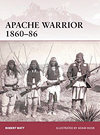
Apache Warrior, 1860–86, by Robert N. Watt, Osprey Publishing, Oxford, England, 2014, $18.95
Of all the American Indians who resisted white expansion, none have acquired the reputation for seemingly superhuman endurance and cunning, combined with inhuman cruelty, associated with the Chiricahua Apaches. Previous titles in the Osprey series of military paperbacks have dealt with the guerrilla tactics by which a disproportionate handful of Apache warriors repeatedly frustrated the efforts of U.S. Army troopers and Mexican militiamen alike to subdue them. In this entry in Osprey’s Warrior series, however, University of Birmingham lecturer Robert Watt applies what he learned in his travels through Arizona and New Mexico to describe not only the Apache’s tactics but also the environment and the society from which those tactics—and murderous tendencies—evolved.
Apache Warrior focuses specifically on the Chiricahuas, a people subdivided into four bands—Chíhéne, Bedonkohe, Chokonen and Nednhi—and further complicated by intermarriage with other Apaches. Geronimo, for one, was Bedonkohe by birth but married into the Nednhi. The Chiricahuas based their raiding and fighting methods on the need to maximize damage done to the enemy at the lowest possible cost, because unlike soldiers in the Army, every Apache warrior was also a breadwinner whose loss would be felt throughout the social unit. That philosophic foundation inspired extraordinarily flexible guerrilla tactics.
Among other myths the author tackles is the matter of mutilation, often depicted on film as a ritual similar to that practiced by other Indian tribes. In fact, the Apaches mutilated the fallen primarily for one practical reason: to ensure the enemy was dead.
Apache Warrior should provide some new insights into the Apache wars, though probably not so much in the realm of what they did and how they did it. But Watt does answer “why.”
—Jon Guttman




